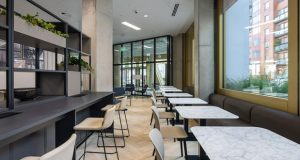Rupert Kazlauciunas of Zehnder Group UK discusses the links between building design and the health and wellbeing of occupants
A study recently conducted in the US revealed that 40 per cent of adult workers have taken a day off sick due to poor air quality in their place of work (see References, note 1). In the UK, we have also seen a reported increase in respiratory sickness, headaches and poor mental health among people working in supposedly ‘sick’ buildings.
First spoken about and highly prevalent in the 1990s, sick building syndrome (SBS) is commonly defined as a ‘medical condition where people in a building suffer from symptoms of illness or feel unwell for no apparent reason. Sick building causes are frequently pinned down to flaws in the heating, ventilation, and air conditioning (HVAC) systems’. Although serious discussions around SBS quietened down in the early 21st century, there are now studies and opinions emerging to suggest the phenomenon is making an unwelcome return to our workplaces and, indeed, our buildings in general.
So how can we address this issue? And what role does building design have to play in finding a solution?
Wellbeing, health and comfort are slowly moving up the agenda in terms of construction and building management as a whole. Major building services and architectural award schemes now regularly feature a ‘health and wellbeing’ category, and several award-winning developments are being commended not only for aesthetic design or sustainability but how the building fabric lends itself to the positive wellbeing of its inhabitants.
In turn, buildings such as schools and offices are beginning to be seen as much more than places where teaching and work happens, and more as part of the solution itself: an effective, positive environment where the very make-up of the building and its features can contribute to the success and happiness of its occupants.
In the working world, many companies are now employing wellbeing officers or heads of employee wellbeing, where the traditional HR role is extended or adapted to cover issues such as physical and mental health, positive working environments and optimal working conditions.
 Any environment where we spend a great deal of time, whether it’s an office, school or healthcare facility, needs to have fundamental features in place to ensure we are comfortable. This includes quality of light, air quality, adequate space and ideal temperature. No matter how interesting the lesson, productive the meeting or delicious the canteen food, the experiences we have in these settings are compromised if we feel uncomfortable. It’s a simple fact: our comfort affects our ability to concentrate, enjoy ourselves and be productive.
Any environment where we spend a great deal of time, whether it’s an office, school or healthcare facility, needs to have fundamental features in place to ensure we are comfortable. This includes quality of light, air quality, adequate space and ideal temperature. No matter how interesting the lesson, productive the meeting or delicious the canteen food, the experiences we have in these settings are compromised if we feel uncomfortable. It’s a simple fact: our comfort affects our ability to concentrate, enjoy ourselves and be productive.
FOCUS AND CONCENTRATION
For effective working or learning to take place, a combination of stimulation and concentration in the workplace is required. Much of the stimulation aspect will arise from the work itself: interesting topics, engaging resources and lively discussion. Concentration is a little more complex.
Individual factors, of course, contribute to this. How willing are people to participate? How much sleep have they had? What is their personality type? But basic human and environmental conditions also play a part. Being hungry, overtired, feeling too hot or too cold also affect how much attention we can pay and how much information we can process.
Take thermal comfort (2). Being too hot or cold seriously impairs our comfort level and can distract us from focusing on anything else – our human instincts prompt us to redress the balance and adjust our temperature until we feel ‘just right’. In working environments, this distraction can lead to reduced concentration, disruption and ultimately, a lack of effective working. In an office or employment setting, this may lead to dissatisfaction on the part of both employee and employer as productivity levels drop and the quality of work is compromised. As a result, symptoms of so-called SBS may rise, leading to an increase in sick days.
Noise is also an issue. Public buildings such as offices and schools are expected to be busy, bustling places, but providing for quiet in these environments, or at least a respite from distracting background noise, can significantly boost productivity and learning.
A study conducted by Belgian researchers(3) and published in the Journal of Neuroscience shows that this is particularly true of younger people. The study revealed that the brains of children aged six to nine ‘have a significantly harder time than adult brains tracking and distinguishing voices amid background noise’.
Another important consideration is lighting. A University of Cambridge study(4) presented at the British Educational Research Association in 2007 showed that if rooms were too bright, occupants developed headaches and other symptoms which prevented them from concentrating. Flickering fluorescent panels were found to be not only too bright but also a source of distraction and discomfort.




